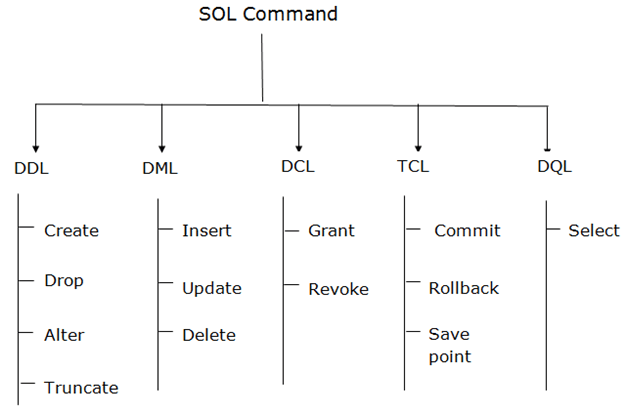TheDeveloperBlog.com
C-Sharp | Java | Python | Swift | GO | WPF | Ruby | Scala | F# | JavaScript | SQL | PHP | Angular | HTML
SQL Commands: DDL, DML, DCL, TCL, DQL
DBMS SQL Commands: DDL, DML, DCL, TCL, DQL with DBMS Overview, DBMS vs Files System, DBMS Architecture, Three schema Architecture, DBMS Language, DBMS Keys, DBMS Generalization, DBMS Specialization, Relational Model concept, SQL Introduction, Advantage of SQL, DBMS Normalization, Functional Dependency, DBMS Schedule, Concurrency Control etc.
SQL Commands
Types of SQL Commands
There are five types of SQL commands: DDL, DML, DCL, TCL, and DQL. 
1. Data Definition Language (DDL)
Here are some commands that come under DDL:
a. CREATE It is used to create a new table in the database. Syntax: CREATE TABLE TABLE_NAME (COLUMN_NAME DATATYPES[,....]); Example: CREATE TABLE EMPLOYEE(Name VARCHAR2(20), Email VARCHAR2(100), DOB DATE); b. DROP: It is used to delete both the structure and record stored in the table. Syntax DROP TABLE table_name; Example DROP TABLE EMPLOYEE; c. ALTER: It is used to alter the structure of the database. This change could be either to modify the characteristics of an existing attribute or probably to add a new attribute. Syntax: To add a new column in the table ALTER TABLE table_name ADD column_name COLUMN-definition; To modify existing column in the table: ALTER TABLE table_name MODIFY(column_definitions....); EXAMPLE ALTER TABLE STU_DETAILS ADD(ADDRESS VARCHAR2(20)); ALTER TABLE STU_DETAILS MODIFY (NAME VARCHAR2(20)); d. TRUNCATE: It is used to delete all the rows from the table and free the space containing the table. Syntax: TRUNCATE TABLE table_name; Example: TRUNCATE TABLE EMPLOYEE; 2. Data Manipulation Language
Here are some commands that come under DML:
a. INSERT: The INSERT statement is a SQL query. It is used to insert data into the row of a table. Syntax: INSERT INTO TABLE_NAME (col1, col2, col3,.... col N) VALUES (value1, value2, value3, .... valueN); Or INSERT INTO TABLE_NAME VALUES (value1, value2, value3, .... valueN); For example:
INSERT INTO TheDeveloperBlog (Author, Subject) VALUES ("Sonoo", "DBMS");
b. UPDATE: This command is used to update or modify the value of a column in the table. Syntax: UPDATE table_name SET [column_name1= value1,...column_nameN = valueN] [WHERE CONDITION] For example: UPDATE students SET User_Name = 'Sonoo' WHERE Student_Id = '3' c. DELETE: It is used to remove one or more row from a table. Syntax: DELETE FROM table_name [WHERE condition]; For example: DELETE FROM TheDeveloperBlog WHERE Author="Sonoo"; 3. Data Control LanguageDCL commands are used to grant and take back authority from any database user. Here are some commands that come under DCL:
a. Grant: It is used to give user access privileges to a database. Example GRANT SELECT, UPDATE ON MY_TABLE TO SOME_USER, ANOTHER_USER; b. Revoke: It is used to take back permissions from the user. Example REVOKE SELECT, UPDATE ON MY_TABLE FROM USER1, USER2; 4. Transaction Control LanguageTCL commands can only use with DML commands like INSERT, DELETE and UPDATE only. These operations are automatically committed in the database that's why they cannot be used while creating tables or dropping them. Here are some commands that come under TCL:
a. Commit: Commit command is used to save all the transactions to the database. Syntax: COMMIT; Example: DELETE FROM CUSTOMERS WHERE AGE = 25; COMMIT; b. Rollback: Rollback command is used to undo transactions that have not already been saved to the database. Syntax: ROLLBACK; Example: DELETE FROM CUSTOMERS WHERE AGE = 25; ROLLBACK; c. SAVEPOINT: It is used to roll the transaction back to a certain point without rolling back the entire transaction. Syntax: SAVEPOINT SAVEPOINT_NAME; 5. Data Query LanguageDQL is used to fetch the data from the database. It uses only one command:
a. SELECT: This is the same as the projection operation of relational algebra. It is used to select the attribute based on the condition described by WHERE clause. Syntax: SELECT expressions FROM TABLES WHERE conditions; For example: SELECT emp_name FROM employee WHERE age > 20;
Next TopicDBMS SQL Operator
|
Related Links:
- DBMS Multivalued Dependency
- DBMS Inclusion Dependence
- DBMS SQL Set Operation
- Top 52 DBMS Interview Questions (2021)
- DBMS Transaction Processing Concept
- DBMS States of Transaction
- DBMS Schedule
- DBMS Conflict Serializable Schedule
- DBMS View Serializability
- DBMS Recoverability of Schedule
- DBMS Tutorial | Database Management System
- DBMS Failure Classification
- DBMS Concurrency Control
- DBMS Lock based Protocol
- DBMS Log-Based Recovery
- DBMS Checkpoint
- DBMS Timestamp Ordering Protocol
- DBMS Validation based Protocol
- DBMS Thomas Write Rule
- DBMS Multiple Granularity
- DBMS Sequential File Organization
- DBMS Recovery Concurrent Transaction
- DBMS Characteristics of SQL
- DBMS File organization
- DBMS Heap File Organization
- DBMS Hash File Organization
- DBMS B+ Tree
- DBMS RAID
- DBMS B+ File Organization
- DBMS Indexed Sequential Access Method
- DBMS Cluster File Organization
- DBMS Hashing
- DBMS Static Hashing
- DBMS Dynamic Hashing
- DBMS SQL Introduction
- DBMS Advantage of SQL
- SQL Commands: DDL, DML, DCL, TCL, DQL
- DBMS SQL Operator
- DBMS SQL Insert
- DBMS SQL Update
- DBMS SQl Datatype
- DBMS SQL Table
- DBMS SQL Select
- DBMS SQL Index
- DBMS SQL Sub Queries
- DBMS SQL Clauses
- DBMS Generalization
- DBMS Specialization
- DBMS vs Files System
- DBMS Architecture
- DBMS SQL Delete
- DBMS SQL View
- DBMS Three schema Architecture
- DBMS Data model schema and Instance
- DBMS Join Operation
- DBMS Notation for ER diagram
- DBMS Relational Calculus
- DBMS Data Independence
- DBMS Language
- DBMS ER model concept
- DBMS Mapping constraints
- DBMS Keys: Primary, Foreign, Candidate and Super Key
- DBMS Aggregation
- DBMS Join Dependency
- DBMS Convert ER into table
- DBMS Relationship of Higher Degree
- DBMS Relational Model concept
- DBMS Relational Algebra
- DBMS Integrity Constraints
- DBMS Functional Dependency
- DBMS Inference Rule
- DBMS Normalization: 1NF, 2NF, 3NF and BCNF with Examples
- DBMS Transaction Property
- DBMS Testing of Serializability
- DBMS 1NF
- DBMS 2NF
- DBMS SQL Aggregate function
- DBMS SQL Joins
- DBMS 3NF
- DBMS BCNF
- DBMS 4NF
- DBMS 5NF
- DBMS Relational Decomposition

